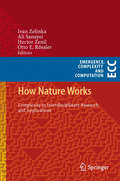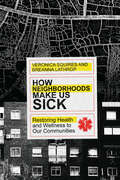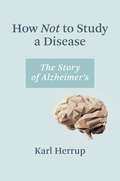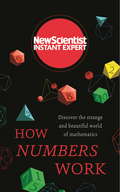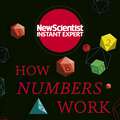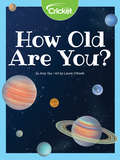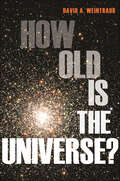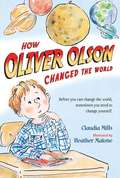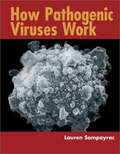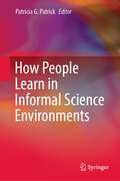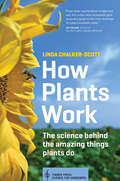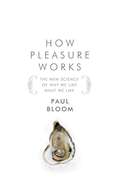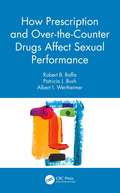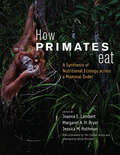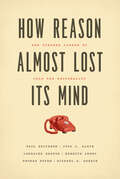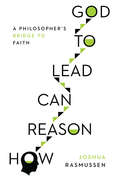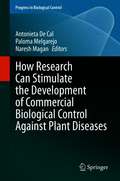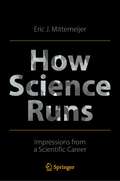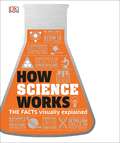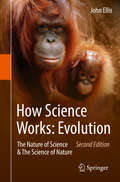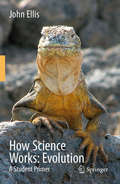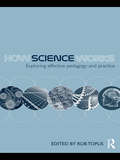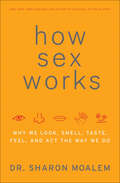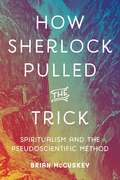- Table View
- List View
How Nature Works: Complexity in Interdisciplinary Research and Applications
by Ali Sanayei Otto E. Rössler Hector Zenil Ivan ZelinkaThis book is based on the outcome of the "2012 Interdisciplinary Symposium on Complex Systems" held at the island of Kos. The book consists of 12 selected papers of the symposium starting with a comprehensive overview and classification of complexity problems, continuing by chapters about complexity, its observation, modeling and its applications to solving various problems including real-life applications. More exactly, readers will have an encounter with the structural complexity of vortex flows, the use of chaotic dynamics within evolutionary algorithms, complexity in synthetic biology, types of complexity hidden inside evolutionary dynamics and possible controlling methods, complexity of rugged landscapes, and more. All selected papers represent innovative ideas, philosophical overviews and state-of-the-art discussions on aspects of complexity. The book will be useful as instructional material for senior undergraduate and entry-level graduate students in computer science, physics, applied mathematics and engineering-type work in the area of complexity. The book will also be valuable as a resource of knowledge for practitioners who want to apply complexity to solve real-life problems in their own challenging applications. The authors and editors hope that readers will be inspired to do their own experiments and simulations, based on information reported in this book, thereby moving beyond the scope of the book.
How Neighborhoods Make Us Sick: Restoring Health and Wellness to Our Communities
by Veronica Squires Breanna LathropOur neighborhoods are literally making us sick. Buildings with mold trigger asthma and other respiratory conditions. Geographic lack of access to food and health care increases childhood mortality. Community violence traumatizes residents. Poverty, unemployment, inadequate housing, food insecurity, racial injustice, and oppression cause physical changes in the body, resulting in disease and death. But there is hope. Loving our neighbor includes creating social environments in which people can be healthy. While working in community redevelopment and treating uninsured families, Veronica Squires and Breanna Lathrop discovered that creating healthier neighborhoods requires a commitment to health equity. Jesus' ministry brought healing through dismantling systems of oppression and overturning social norms that prevented people from living healthy lives. We can do the same in our communities through addressing social determinants that facilitate healing in under-resourced neighborhoods. Everyone deserves the opportunity for good health. The decisions we make and actions we take can promote the health of our neighbors.
How Not to Study a Disease: The Story of Alzheimer's
by Karl HerrupAn authority on Alzheimer's disease offers a history of past failures and a roadmap that points us in a new direction in our journey to a cure.For decades, some of our best and brightest medical scientists have dedicated themselves to finding a cure for Alzheimer's disease. What happened? Where is the cure? The biggest breakthroughs occurred twenty-five years ago, with little progress since. In How Not to Study a Disease, neurobiologist Karl Herrup explains why the Alzheimer's discoveries of the 1990s didn't bear fruit and maps a direction for future research. Herrup describes the research, explains what's taking so long, and offers an approach for resetting future research.Herrup offers a unique insider's perspective, describing the red flags that science ignored in the rush to find a cure. He is unsparing in calling out the stubbornness, greed, and bad advice that has hamstrung the field, but his final message is a largely optimistic one. Herrup presents a new and sweeping vision of the field that includes a redefinition of the disease and a fresh conceptualization of aging and dementia that asks us to imagine the brain as a series of interconnected "neighborhoods." He calls for changes in virtually every aspect of the Alzheimer's disease research effort, from the drug development process, to the mechanisms of support for basic research, to the often-overlooked role of the scientific media, and more. With How Not to Study a Disease, Herrup provides a roadmap that points us in a new direction in our journey to a cure for Alzheimer's.
How Numbers Work: Discover the strange and beautiful world of mathematics (New Scientist Instant Expert Ser.)
by New ScientistThink of a number between one and ten. No, hang on, let's make this interesting. Between zero and infinity. Even if you stick to the whole numbers, there are a lot to choose from - an infinite number in fact. Throw in decimal fractions and infinity suddenly gets an awful lot bigger (is that even possible?) And then there are the negative numbers, the imaginary numbers, the irrational numbers like pi which never end. It literally never ends. <P><P>The world of numbers is indeed strange and beautiful. Among its inhabitants are some really notable characters - pi, e, the "imaginary" number i and the famous golden ratio to name just a few. Prime numbers occupy a special status. Zero is very odd indeed: is it a number, or isn't it? <P><P>How Numbers Work takes a tour of this mind-blowing but beautiful realm of numbers and the mathematical rules that connect them. Not only that, but take a crash course on the biggest unsolved problems that keep mathematicians up at night, find out about the strange and unexpected ways mathematics influences our everyday lives, and discover the incredible connection between numbers and reality itself. <P><P>ABOUT THE SERIES <P><P>New Scientist Instant Expert books are definitive and accessible entry points to the most important subjects in science; subjects that challenge, attract debate, invite controversy and engage the most enquiring minds. Designed for curious readers who want to know how things work and why, the Instant Expert series explores the topics that really matter and their impact on individuals, society, and the planet, translating the scientific complexities around us into language that's open to everyone, and putting new ideas and discoveries into perspective and context.
How Numbers Work: Discover the strange and beautiful world of mathematics (New Scientist Instant Expert)
by New ScientistHow Numbers Work is a tour of the mind-blowing but beautiful realm of numbers and the mathematical rules that connect them.Think of a number between one and ten. No, hang on, let's make this interesting. Between zero and infinity. Even if you stick to the whole numbers, there are a lot to choose from - an infinite number in fact. Throw in decimal fractions and infinity suddenly gets an awful lot bigger (is that even possible?) And then there are the negative numbers, the imaginary numbers, the irrational numbers like pi which never end. It literally never ends.The world of numbers is indeed strange and beautiful. Among its inhabitants are some really notable characters - pi, e, the "imaginary" number i and the famous golden ratio to name just a few. Prime numbers occupy a special status. Zero is very odd indeed: is it a number, or isn't it?How Numbers Work takes a tour of this mind-blowing but beautiful realm of numbers and the mathematical rules that connect them. Not only that, but take a crash course on the biggest unsolved problems that keep mathematicians up at night, find out about the strange and unexpected ways mathematics influences our everyday lives, and discover the incredible connection between numbers and reality itself. ABOUT THE SERIESNew Scientist Instant Expert books are definitive and accessible entry points to the most important subjects in science; subjects that challenge, attract debate, invite controversy and engage the most enquiring minds. Designed for curious readers who want to know how things work and why, the Instant Expert series explores the topics that really matter and their impact on individuals, society, and the planet, translating the scientific complexities around us into language that's open to everyone, and putting new ideas and discoveries into perspective and context.(P)2018 Hodder & Stoughton Limited
How Old Are You?
by Amy TaoWhen it’s your birthday, you add one Earth year to your age. Have you ever wondered how old you would be in Saturn years? What about Mars? Read on to learn about the planets of our solar system and how long it takes for them to complete one whole orbit.
How Old Is the Universe?
by David A. WeintraubHow a great enigma of astronomy was solvedAstronomers have determined that our universe is 13.7 billion years old. How exactly did they come to this precise conclusion? How Old Is the Universe? tells the incredible story of how astronomers solved one of the most compelling mysteries in science and, along the way, introduces readers to fundamental concepts and cutting-edge advances in modern astronomy.The age of our universe poses a deceptively simple question, and its answer carries profound implications for science, religion, and philosophy. David Weintraub traces the centuries-old quest by astronomers to fathom the secrets of the nighttime sky. Describing the achievements of the visionaries whose discoveries collectively unveiled a fundamental mystery, he shows how many independent lines of inquiry and much painstakingly gathered evidence, when fitted together like pieces in a cosmic puzzle, led to the long-sought answer. Astronomers don't believe the universe is 13.7 billion years old—they know it. You will too after reading this book. By focusing on one of the most crucial questions about the universe and challenging readers to understand the answer, Weintraub familiarizes readers with the ideas and phenomena at the heart of modern astronomy, including red giants and white dwarfs, cepheid variable stars and supernovae, clusters of galaxies, gravitational lensing, dark matter, dark energy and the accelerating universe—and much more. Offering a unique historical approach to astronomy, How Old Is the Universe? sheds light on the inner workings of scientific inquiry and reveals how astronomers grapple with deep questions about the physical nature of our universe.
How Oliver Olson Changed the World
by Claudia MillsAfraid he will always be an outsider like ex-planet Pluto, nine-year-old Oliver finally shows his extremely overprotective parents that he is capable of doing great things without their help while his class is studying the solar system.
How Pathogenic Viruses Work
by Lauren SompayracAddressing students in nine informal-lecture-like chapters, Sompayrac (retired, molecular, cellular, and developmental biology, U. of Colorado, Boulder) discusses the properties of viruses using an instruction strategy distinguished from conventional approaches, which focus mainly on the cells that viruses inhabit, rather than the viruses themselves. He uses 12 of the most common viral infections as examples to demonstrate how "fathoming the mind of a virus"--that is, understanding the "problems" they face--can help in understanding that diseases are viruses' various solutions to staying alive. A brief glossary is included, but there is no bibliography. Annotation c. Book News, Inc., Portland, OR (booknews.com)
How People Learn in Informal Science Environments?
by Patricia G. PatrickThis edited volume brings together an international perspective of 22 diverse learning theories applied to a range of informal science learning environments. The book is divided into 7 sections: community of practice, critical theory, identity theory, sociocultural, socioscientific, and social entrepreneurship, systems theory, and theory development. The chapters present how researchers from diverse backgrounds and cultures use theories in their work and how these may be applied as theoretical frameworks for future research. The chapters bridge theory and practice and collectively address a wide range of ages (children-adults) and contexts. The book is written to engage a broad audience of researchers in universities and museums, while appealing to the growing number of researchers and educators who recognize the importance of informal learning to the development of environmental and scientific literacy. It is essential reading for inexperienced researchers and those seeking new theoretical perspectives.
How Plants Work: The Science Behind the Amazing Things Plants Do (Science For Gardeners Ser.)
by Linda Chalker-ScottThe more you know, the better you grow! Plants are capable of interesting and unexpected things. Why do container plants wilt when they’ve been regularly watered? Why did the hydrangea that thrived last year never bloom this year? Why do slugs wipe out the vegetable garden instead of eating the weeds? Plant physiology—the study of how living things function—can solve these and most other problems gardeners regularly encounter.In How Plants Work, horticulture expert and contributor to the popular blog The Garden Professors, Linda Chalker-Scott brings the stranger-than-fiction science of the plant world to vivid life. She uncovers the mysteries of how and why plants do the things they do, and arms the home gardener with fascinating knowledge that will change the way they garden.
How Pleasure Works: The New Science Of Why We Like What We Like
by Paul BloomPleasure is anything but straightforward. Our desires, attractions, and tastes take us beyond the symmetry of a beautiful face, the sugar and fat in food, or the prettiness of a painting. In How Pleasure Works, Yale University psychologist Paul Bloom draws on groundbreaking research to unveil the deeper workings of why we desire what we desire. Refuting the longstanding explanation of pleasure as a simple sensory response, Bloom shows us that pleasure is grounded in our beliefs about the deeper nature or essence of a given thing. This is why we want the real Rolex and not the knockoff, the real Picasso and not the fake, the twin we have fallen in love with and not her identical sister. In this fascinating and witty account, Bloom draws on child development, philosophy, neuroscience, and behavioral economics in order to address pleasures noble and seamy, highbrow and lowbrow. Along the way, he gives us unprecedented insights into a realm of human psychology that until now has only been partially understood.
How Prescription and Over-the-Counter Drugs Affect Sexual Performance
by Robert B. Raffa Patricia J. Bush Albert I. WertheimerMost adults take at least one prescription medication for example, for high blood pressure, high cholesterol levels, depression, asthma, diabetes, COPD, or a variety of other reasons, but most people (and many healthcare providers) are totally unaware that medications can have direct negative effects on sexual functioning and performance. This informative and timely book written by three well-known medications experts explores the chemistry behind sexual arousal in men and women and clearly and authoritatively explains how the common categories of prescription and over-the-counter medications and abused substances might be the reason for their declining sexual performance or even interest.
How Primates Eat: A Synthesis of Nutritional Ecology across a Mammal Order
by Alison RichardExploring everything from nutrients to food acquisition and research methods, a comprehensive synthesis of the study of diet and feeding in nonhuman primates. What do we mean when we say that a diet is nutritious? Why can some animals get all the energy they need from eating leaves while others would perish on such a diet? Why don’t mountain gorillas eat fruit all day as chimpanzees do? Answers to these questions about food and feeding are among the many tasty morsels that emerge from this authoritative book. Informed by the latest scientific tools and millions of hours of field and laboratory work on species across the primate order and around the globe, this volume is an exhaustive synthesis of our understanding of what, why, and how primates eat. State-of-the-art information presented at physiological, behavioral, ecological, and evolutionary scales will serve as a road map for graduate students, researchers, and practitioners as they work toward a holistic understanding of life as a primate and the urgent conservation consequences of diet and food availability in a changing world.
How Reason Almost Lost Its Mind: The Strange Career of Cold War Rationality
by Paul Erickson Judy L. Klein Lorraine Daston Rebecca Lemov Thomas Sturm Michael D. GordinIn the United States at the height of the Cold War, roughly between the end of World War II and the early 1980s, a new project of redefining rationality commanded the attention of sharp minds, powerful politicians, wealthy foundations, and top military brass. Its home was the human sciences—psychology, sociology, political science, and economics, among others—and its participants enlisted in an intellectual campaign to figure out what rationality should mean and how it could be deployed. How Reason Almost Lost Its Mind brings to life the people—Herbert Simon, Oskar Morgenstern, Herman Kahn, Anatol Rapoport, Thomas Schelling, and many others—and places, including the RAND Corporation, the Center for Advanced Study in the Behavioral Sciences, the Cowles Commission for Research and Economics, and the Council on Foreign Relations, that played a key role in putting forth a “Cold War rationality.” Decision makers harnessed this picture of rationality—optimizing, formal, algorithmic, and mechanical—in their quest to understand phenomena as diverse as economic transactions, biological evolution, political elections, international relations, and military strategy. The authors chronicle and illuminate what it meant to be rational in the age of nuclear brinkmanship.
How Reason Can Lead to God: A Philosopher's Bridge to Faith
by Joshua RasmussenDo you seek the truth?
How Research Can Stimulate the Development of Commercial Biological Control Against Plant Diseases (Progress in Biological Control #21)
by Antonieta De Cal Paloma Melgarejo Naresh MaganBiological control has become an attractive alternative strategy for the control of plant diseases to reduce the excessive use of agrochemicals and its health hazards. But a significant gap still exists between basic research involving the discovery of a biocontrol agent and its development and implementation under commercial conditions. Because BCAs (unlike chemical a.m.) need to establish, colonize, survive and perform their metabolic activity to control diseases. In order to move a biocontrol agent from the laboratory to the market place requires many different disciplines and people with a variety of expertise. Research can stimulate the development of commercial biocontrol agents.Chapter 16 is available open access under a Creative Commons Attribution 4.0 International License via link.springer.com.
How Science Runs: Impressions from a Scientific Career
by Eric J. MittemeijerThis book offers a considered yet entertaining reflection on the progress of modern scientific research. The winding path of science can only be understood by revealing the personal, human side of scientific research, demystifying the actions of the scientist and exposing the human drama on the stage of science. The book looks at the true nature of contemporary science and scientists through the lens of the personal experiences of the author, a renowned and leading materials scientist, over the last half century. It examines the positive threads of modern scientific progress in sober juxtaposition to the manifest negative developments arising from stiff competition within the current academic landscape. A collection of stories and real-life anecdotes is presented in parallel to the career of the author, providing a first-hand account of important achievements in the field of materials science. As a result, this book provides fascinating reading for students, seasoned scientists, and anybody else interested in the workings and machinations of modern science.
How Science Works: The Facts Simply Explained (How Things Work)
by Dorling Kindersley Publishing StaffHow Science Works uses clear, easy-to-understand graphics to answer common questions and explain difficult concepts--not only the core science topics that eluded us at school, but also the cutting-edge science reported in the news. <p><p> Have you ever wondered how airplanes stay in the air, how holograms are made, or how ants lift things many times their size? You'll find answers to these enigmas as well as learn about more complex developments, including the discovery of the Higgs boson, gravitational waves, and the mysteries of dark matter. Topic spreads include Q&A features, short-story sections, and simple graphics to answer all your questions about scientific principles, from familiar conundrums to mysteries that evade even the brightest minds.
How Science Works: Evolution
by John EllisEvolution is just a theory, isn't it? What is a scientific theory anyway? Don't scientists prove things? What is the difference between a fact, a hypothesis and a theory in science? How does scientific thinking differ from religious thinking? Why are most leading scientists atheists? Are science and religion compatible? Why are there so many different religious beliefs but only one science? What is the evidence for evolution? Why does evolution occur? If you are interested in any of these questions and have some knowledge of biology, this book is for you.
How Science Works: Evolution
by R. John EllisEvolution is just a theory, isn't it? What is a scientific theory anyway? Don't scientists prove things? What is the difference between a fact, a hypothesis and a theory in science? How does scientific thinking differ from religious thinking? Why are most leading scientists atheists? Are science and religion compatible? Why are there so many different religious beliefs but only one science? What is the evidence for evolution? Why does evolution occur? If you are interested in any of these questions and have some knowledge of biology, this book is for you.
How Science Works: Exploring effective pedagogy and practice
by Rob ToplisHow Science Works provides student and practising teachers with a comprehensive introduction to one of the most dramatic changes to the secondary science curriculum.? Underpinned by the latest research in the field, it explores the emergence and meaning of How Science Works and reviews major developments in pedagogy and practice. With chapters structured around three key themes - why How Science Works, what it is and how to teach it – expert contributors explore issues including the need for curriculum change, arguments for scientific literacy for all, school students’ views about science, what we understand about scientific methods, types of scientific enquiry, and, importantly, effective pedagogies and their implications for practice. Aiming to promote discussion and reflection on the ways forward for this new and emerging area of the school science curriculum, it considers: teaching controversial issues in science argumentation and questioning for effective teaching enhancing investigative science and developing reasoned scientific judgments the role of ICT in exploring How Science Works teaching science outside the classroom. How Science Works is a source of guidance for all student, new and experienced teachers of secondary science, interested in investigating how the curriculum can provide creativity and engagement for all school students.
How A Seed Grows
by Helene J. JordanHow does a tiny acorn grow into an enormous oak tree? With beautiful and accurate watercolor illustrations from Loretta Krupinski, this book by Helene Jordan traces the process of how a little seed grows into the plants and trees that surround us.
How Sex Works: Why We Look, Smell, Taste, Feel, and Act the Way We Do
by Sharon Moalem“Read this book and discover sex again, but from a scientific perspective, and see why it evolved. It’s almost as much fun, and needs less energy.” — Peter Macinnis, author of 100 Discoveries: The Greatest Breakthroughs in History "How Sex Works manages to inject science writing with the prurient thrill of a gossip rag." —O magazineMedical maverick and New York Times bestselling author of Survival of the Sickest Dr. Sharon Moalem presents an insightful and engaging voyage through the surprising history and evolution of sexual reproduction. Fans of Freakonomics, Blink, You: The Owner’s Manual, and Why Do Men Have Nipples will find many engaging insights in How Sex Works.
How Sherlock Pulled the Trick: Spiritualism and the Pseudoscientific Method
by Brian McCuskeyA masterful combination of literary study and author biography, How Sherlock Pulled the Trick guides us through the parallel careers of two inseparable men: Sherlock Holmes and his creator, Sir Arthur Conan Doyle. Reconsidering Holmes in light of Doyle’s well-known belief in Victorian spiritualism, Brian McCuskey argues that the so-called scientific detective follows the same circular logic, along the same trail of questionable evidence, that led Doyle to the séance room.Holmes’s first case, A Study in Scarlet, was published in 1887, when natural scientists and religious apologists were hotly debating their differences in the London press. In this environment, Doyle became convinced that spiritualism, as a universal faith based on material evidence, resolved the conflict between science and religion. The character of Holmes, with his infallible logic, was Doyle’s good faith solution to the cultural conflicts of his day. Yet this solution has evolved into a new problem. Sherlock Holmes now authorizes the pseudoscience that corrupts our public sphere, defying logic, revising history, and promoting conspiracy theories. As this book demonstrates, wearing a deerstalker does not make you a mastermind—more likely, it marks you as a crackpot.Fascinating and highly readable, How Sherlock Pulled the Trick returns the iconic Holmes to his mystical origins.
